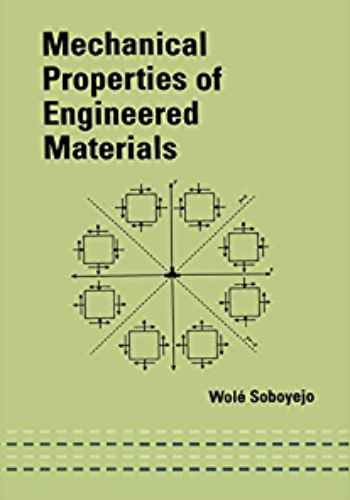Admin
مدير المنتدى


عدد المساهمات : 18994
التقييم : 35488
تاريخ التسجيل : 01/07/2009
الدولة : مصر
العمل : مدير منتدى هندسة الإنتاج والتصميم الميكانيكى
 |  موضوع: كتاب Mechanical Properties of Engineered Materials موضوع: كتاب Mechanical Properties of Engineered Materials  الثلاثاء 29 مايو 2012, 7:58 am الثلاثاء 29 مايو 2012, 7:58 am | |
| 
تذكير بمساهمة فاتح الموضوع : أخواني في الله
أحضرت لكم كتاب
Mechanical Properties of Engineered Materials
Wolé Soboyejo
Princeton University
Princeton, New Jersey

و المحتوى كما يلي :
Contents
Preface
1 Overview of Crystal/Defect Structure and Mechanical Properties
and Behavior
1.1 Introduction
1.2 Atomic Structure
1.3 Chemical Bonds
1.4 Structure of Solids
1.5 Structural Length Scales: Nanostructure, Microstructure,
and Macrostructure
1.6 Summary
Bibliography
2 Defect Structure and Mechanical Properties
2.1 Introduction
2.2 Indicial Notation for Atomic Planes and Directions
2.3 Defects
2.4 Thermal Vibrations and Microstructural Evolution
2.5 Overview of Mechanical Behavior
2.6 SummaryBibliography
3 Basic Definitions of Stress and Strain
3.1 Introduction
3.2 Basic Definitions of Stress
3.3 Basic Definitions of Strain
3.4 Mohr’s Circle of Stress and Strain
3.5 Computation of Principal Stresses and Principal Strains
3.6 Hydrostatic and Deviatoric Stress Components
3.7 Strain Measurement
3.8 Mechanical Testing
3.9 Summary
Bibliography
4 Introduction to Elastic Behavior
4.1 Introduction
4.2 Reasons for Elastic Behavior
4.3 Introduction to Linear Elasticity
4.4 Theory of Elasticity
4.5 Introduction to Tensor Notation
4.6 Generalized Form of Linear Elasticity
4.7 Strain Energy Density Function
4.8 Summary
Bibliography
5 Introduction to Plasticity
5.1 Introduction
5.2 Physical Basis for Plasticity
5.3 Elastic–Plastic Behavior
5.4 Empirical Stress–Strain Relationships
5.5 Considere Criterion
5.6 Yielding Under Multiaxial Loading
5.7 Introduction to J2 Deformation Theory
5.8 Flow and Evolutionary Equations
(Constitutive Equations of Plasticity)
5.9 SummaryBibliography
6 Introduction to Dislocation Mechanics
6.1 Introduction
6.2 Theoretical Shear Strength of a Crystalline Solid
6.3 Types of Dislocations
6.4 Movement of Dislocations
6.5 Experimental Observations of Dislocations
6.6 Stress Fields Around Dislocations
6.7 Strain Energies
6.8 Forces on Dislocations
6.9 Forces Between Dislocations
6.10 Forces Between Dislocations and Free Surfaces
6.11 Summary
Bibliography
7 Dislocations and Plastic Deformation
7.1 Introduction
7.2 Dislocation Motion in Crystals
7.3 Dislocation Velocity
7.4 Dislocation Interactions
7.5 Dislocation Bowing Due to Line Tension
7.6 Dislocation Multiplication
7.7 Contributions from Dislocation Density to
Macroscopic Strain
7.8 Crystal Structure and Dislocation Motion
7.9 Critical Resolved Shear Stress and Slip in Single
Crystals
7.10 Slip in Polycrystals
7.11 Geometrically Necessary and Statistically Stored
Dislocations
7.12 Dislocation Pile-Ups and Bauschinger Effect
7.13 Mechanical Instabilities and Anomalous/Serrated
Yielding
7.14 Summary
Bibliography8 Dislocation Strengthening Mechanisms
8.1 Introduction
8.2 Dislocation Interactions with Obstacles
8.3 Solid Solution Strengthening
8.4 Dislocation Strengthening
8.5 Grain Boundary Strengthening
8.6 Precipitation Strengthening
8.7 Dispersion Strengthening
8.8 Overall Superposition
8.9 Summary
Bibliography
9 Introduction to Composites
9.1 Introduction
9.2 Types of Composite Materials
9.3 Rule-of-Mixture Theory
9.4 Deformation Behavior of Unidirectional Composites
9.5 Matrix versus Composite Failure Modes in
Unidirectional Composites
9.6 Failure of Off-Axis Composites
9.7 Effects of Whisker/Fiber Length on Composite
Strength and Modulus
9.8 Constituent and Composite Properties
9.9 Statistical Variations in Composite Strength
9.10 Summary
Bibliography
10 Further Topics in Composites
10.1 Introduction
10.2 Unidirectional Laminates
10.3 Off-Axis Laminates
10.4 Multiply Laminates
10.5 Composite Ply Design
10.6 Composite Failure Criteria
10.7 Shear Lag Theory
10.8 The Role of Interfaces
10.9 SummaryBibliography
11 Fundamentals of Fracture Mechanics
11.1 Introduction
11.2 Fundamentals of Fracture Mechanics
11.3 Notch Concentration Factors
11.4 Griffith Fracture Analysis
11.5 Energy Release Rate and Compliance
11.6 Linear Elastic Fracture Mechanics
11.7 Elastic–Plastic Fracture Mechanics
11.8 Fracture Initiation and Resistance
11.9 Interfacial Fracture Mechanics
11.10 Dynamic Fracture Mechanics
11.11 Summary
Bibliography
12 Mechanisms of Fracture
12.1 Introduction
12.2 Fractographic Analysis
12.3 Toughness and Fracture Process Zones
12.4 Mechanisms of Fracture in Metals and Their Alloys
12.5 Fracture of Intermetallics
12.6 Fracture of Ceramics
12.7 Fracture of Polymers
12.8 Fracture of Composites
12.9 Quantitative Fractography
12.10 Thermal Shock Response
12.11 Summary
Bibliography
13 Toughening Mechanisms
13.1 Introduction
13.2 Toughening and Tensile Strength
13.3 Review of Composite Materials
13.4 Transformation Toughening
13.5 Crack Bridging13.6 Crack-Tip Blunting
13.7 Crack Deflection
13.8 Twin Toughening
13.9 Crack Trapping
13.10 Microcrack Shielding/Antishielding
13.11 Linear Superposition Concept
13.12 Synergistic Toughening Concept
13.13 Toughening of Polymers
13.14 Summary and Concluding Remarks
Bibliography
14 Fatigue of Materials
14.1 Introduction
14.2 Micromechanisms of Fatigue Crack Initiation
14.3 Micromechanisms of Fatigue Crack Propagation
14.4 Conventional Approach to Fatigue
14.5 Differential Approach to Fatigue
14.6 Fatigue Crack Growth in Ductile Solids
14.7 Fatigue of Polymers
14.8 Fatigue of Brittle Solids
14.9 Crack Closure
14.10 Short Crack Problem
14.11 Fatigue Growth Laws and Fatigue Life Prediction
14.12 Fatigue of Composites
14.13 Summary
Bibliography
15 Introduction to Viscoelasticity, Creep, and Creep Crack Growth
15.1 Introduction
15.2 Creep and Viscoelasticity in Polymers
15.3 Mechanical Dumping
15.4 Temperature Dependence of Time-Dependent Flow
in Polymers
15.5 Introduction to Creep in Metallic and Ceramic
Materials
15.6 Functional Forms in the Different Creep Regimes
15.7 Secondary Creep Deformation and Diffusion
15.8 Mechanisms of Creep Deformation15.9 Creep Life Prediction
15.10 Creep Design Approaches
15.11 Threshold Stress Effects
15.12 Creep in Composite Materials
15.13 Thermostructural Materials
15.14 Introduction to Superplasticity
15.15 Introduction to Creep Damage and Time-Dependent
Fracture Mechanics
15.16 Summary
Bibliography
كلمة سر فك الضغط : books-world.net
The Unzip Password : books-world.net
أتمنى أن تستفيدوا من محتوى الموضوع وأن ينال إعجابكم
رابط من موقع عالم الكتب لتنزيل كتاب Mechanical Properties of Engineered Materials
رابط مباشر لتنزيل كتاب Mechanical Properties of Engineered Materials 
عدل سابقا من قبل Admin في الخميس 05 أغسطس 2021, 12:29 am عدل 3 مرات |
|







